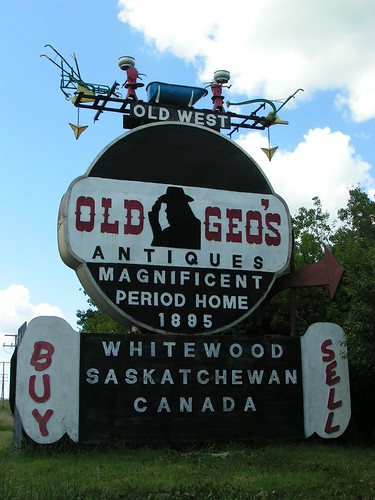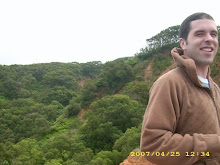
A massive mound of buffalo bones, a ramshackle pioneer village, an old country manor filled to the brim with potential valuable antiques. This is what greeted us when we pulled into Old Geo's Antiques in Whitewood, Saskatchewan last weekend.
Let me give you a little back story first on how we ended up at Old Geo's. My friend owns a burger stand outside of Winnipeg and was in need of a new ice cream machine. He managed to find one on Kijiji, but the seller was in Saskatoon. He agreed to drive to Regina to make it easier. So, my buddy called me up and said, "Hey, I've got to go to Regina. You want to go? We'll have a few drinks. (note: a few drinks was an underestimation)"
We headed off to Regina, picked up the machine, had a few drinks, and woke up the next morning ready to head back to Winnipeg. We got about 175 kilometres east of Regina, when we spotted a towering sign on the north side of the Trans-Canada. It read, "Old Geo's Antiques. Magnificent Period Home. 1895."
Something clicked in my friend's mind and he remembered that his parents had stopped in on a trip home from Calgary and said that the house was interesting and kind of creepy, but worth a stop. So we hung a u-turn and pulled into the house's driveway.
Old Geo's is one of the weirder roadside attractions I have ever seen, but it's really interesting. The house was built in 1895, by immigrants from France, and it's huge. It has seventeen bedrooms and seven staircases. Behind the house, the owner had constructed a pioneer village out of old farm houses, graineries, and scrap wood. To the side of the house is a massive pile of buffalo bones. Needless to say we were a little wary ringing the doorbell.
The owner of Old Geo's is George Chopping, a well-known antiques collector. Old George is a little bit of an eccentric, but a really friendly guy. He took us for a tour of his pioneer village. He's meticulously constructed an authentic pioneer village, filling each building with antiques and period furniture. He's been at it for almost twenty-five years and he's continuously adding on every year. His pride is his saloon. I wish I had a camera (I was a bad journalist) so I could take a picture of his bar. He hand-crafted a bar and it looks like it would be right in place in a high-end saloon, circa 1890.
 Old George Chopping. Photo Credit: Sean Murphy
Old George Chopping. Photo Credit: Sean MurphyGeorge's house is a sight to be seen as well. It is jam-packed, wall to wall with antiques. To say that George is a little bit of a hoarder would be an understatement. George gave us a tour of his place and gave us the history of some of his more prized antiques. He has a massive collection of glass bottles, all from early Western Canada. I don't know much about antiques, but I would assume his collection is worth a lot of money.
George got into collecting antiques when he was still in his teens. "When I was 19, I gave up smoking and drinking and replaced them with collecting," he said. " I guess one addiction replaced another."
The house is full of old household knick-knacks, pioneer clothing, oil lamps, and carvings. George has put some serious effort into his collection. He's received a fair bit of media attention as well, having been profiled by the Saskatchewan Television Network and, surprisingly, the Japanese version of Cosmopolitan magazine.
All in all, the stop at Old Geo's Antiques was worth the time spent. It's an interesting, if not weird roadside attraction. If you're ever driving through eastern Saskatchewan, stop in and see Old George.


